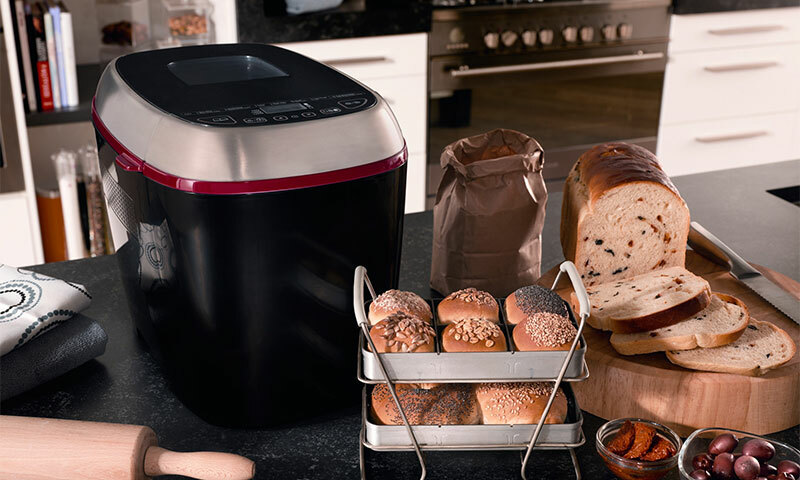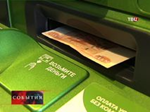The daily receipt of fresh hot bread with a crisp crust for breakfast without much effort and time is a tempting thing. The development of the technical capabilities of household electric appliances allowed to have it even without the night work of a personal chef - with the help of an electric bakery. However, when you first get to know such a device, two questions immediately arise: is he really that good and how to choose a bread maker for "long and faithful" help in the house?

Contents:
- What is electrical bakery
- Parameters of bakery
- Rating of manufacturers
- Price
- Video: how to choose a bakery? Which one is better to buy?
What is the electric bakery
Modern household bakery machines are machines, the smallest samples of which do not exceed the size of a microwave oven, and larger ones are comparable to an oven. Using them for home use allows you not only to constantly receive the freshest bread - you will free the hostess's time and will have only home-made quality of baking on the table.
What she can do
The electric oven performs a full cycle of cooking. It is only necessary to fill in the necessary ingredients in a certain amount and turn on the device, as it starts to knead the dough, in time will combine it with the necessary additives, give it to stand and be baked soft or with a toasted crust.
Choose a bakery with many functions - it means getting an assistant in cooking bakery products of different kinds:
- White wheat and rye bread,
- Cupcake and cake with raisins,
- Sweet buns or French baguettes,
- No-bake or salt-free bread,
- Gluten-free products made from buckwheator rice flour,
- Rolls and pies with different fillings,
- Charlottes, pumpkin, sour cream and other products.
Some bread makers can even cook jam, which is distinguished by the presence of a large number of vitamins, but it is far from always rational in cooking.
Those who have health problems should choose their own small bakery for their home to follow the composition of bread each time and bake a truly dietary, low-calorie or gluten-free product.
The entire process of making home-made bread will take about 3.5 hours in a standard way. Also, bread bakers are usually provided with the function of accelerated cooking, in which a fresh loaf will be ready in just 2 hours. Of course, this is a longer trip to the store, but you yourself will be free for other household chores.

Device and principle of operation
The action of the electric bread maker is based on the operation of the specified programs. Even for the simplest models, they include a series of sequential actions for baking several types of bread, depending on the set of stuffed products:
1. The user selects the recipe, measures the ingredients, puts them into the bakery and sets the program with the buttons on the control panel.
2. The machine starts kneading with a removable tool - blades( blades).They can be several for different purposes, differing in form and material.
3. At the end of kneading, the spatula stops, and the tan comes into operation. It heats the contents of the mold, and the built-in thermal sensor maintains the yeast required for fermentation, and then for baking the temperature regime.
4. The device reports the end of the full cycle with a beep. After it, bread can be pulled out of the apparatus, gently removing it from the blades, from which small holes remain in the rolls.
The "smart" device kneads the yeast dough two times - at the beginning of the work and when it is a little fit. Thanks to this, the bread is made more gentle, evenly filled with air.
Parameters of the bread maker

Before choosing any bread maker model, you need to study its features in detail, and compare them with your needs and possibilities - how often you plan to use it, how much bread you need for your family, where you plan to place the appliance.
Design features
For all the same general design, the individual parts of the breadmaker can differ material and device:
1. The body of the machine is manufactured:
- plastic, reducing the cost of the product, its total weight and maintenance requirements( there are no stains from water on the plastic, iteasy to clean, etc.),
- metallic - more durable, more resistant to higher temperatures and durable.
2. The main element - bucket( or bakery) - can be made:
- made of "stainless steel",
- made of aluminum with non-stick coating, which is considered more convenient.
3. The blade can be two or one. With sufficient power of the device, their number does not affect the quality of the batch, but the amount of rubber gaskets that are insulated from the flow of the bottom of the bucket at the location of the blade is best minimized. The blades themselves can be attached with a whole set, which determines the versatility of the unit.
Technical characteristics of
The main technical indicators of a home bakery are:
- Mold capacity,
- Capacity of the unit.
Form volumes vary for baking weight from 450 g to 1.5 kg. Defining the dimensions you need, consider, in addition to your appetite, the fact that a larger bucket gives a significant increase in overall dimensions of the device. If you have a small kitchen, it is better to pay attention to small-sized models.
Power is reflected in two factors - the quality of the batch and the speed of the general process. For different modifications, it ranges from 450 to 1650 watts, and more powerful specimens are able to prepare more test options, but spend much more electricity. To say specifically, which bread maker is best not. Here you have to choose between functionality and economy.

Additional options
In addition to the most necessary functions, the bread maker can be equipped with some optional but very convenient options:
- A timer that postpones the commencement of the kneading and baking process for a period of 6 to 12 hours, allowing you to prepare loaves for the appointed hour,
- Dispenser, able to add various fillings to rolls, but significantly increases the cost of the stove,
- Protection against voltage fluctuations, increasing the longevity of the machine,
- Child lock inhibitingkryvat cover the unit during cooking,
- stop point of the program, making it possible to continue working with the same point when power outages.
A convenient window in the cover of the device, which makes it possible to observe the product's readiness, can reduce the ability of the stove to create a crust on top of the bread.
With regard to functionality, the machine can support from 3 to 19 programs. Their number makes the bread maker a universal machine, however, not all of them can really and often be required.
Rating of manufacturers - top 6

When choosing among similar models of different manufacturers, the best will always be samples from popular brands, tested by thousands of consumers. In addition, experience shows that it is better to buy a bread maker from a company that produces not only such equipment, but also a whole range of accessories and related products. Among them, Moulinex, Philips, Kenwood, Panasonic, LG have been leading for more than a decade. For them, they write whole cookbooks, they are dedicated to Internet forums. Supra, Mistery, Scarlett can be considered cheaper and possessing "decent" quality.
At the moment, the following bakeries fall into the popularity rating:
1. Moulinex OW613 - allows you to bake a wide range of products, has a power of 700 watts, a metal case, 2 blades for kneading, gives 19 programs, holds up to 1.5 kg of dough, is equipped withdispenser and timer for 15 hours;
2. Panasonic SD-2501WTS - bakes up to 1,25 kg of bread, has a plastic case, 1 blade for kneading, power 550 W, gives 12 programs, is equipped with a timer for 13 hours and a dispenser,
3. Philips HD9016 - bakes up to 1.0 kg, has a power of 500 watts, 1 blade for kneading, plastic case, 12 programs of baking, equipped with a 13-hour timer;
4. Kenwood BM260 - power 455 W, 11 baking programs, bread weight up to 1.0 kg, plastic casing, timer up to 15 hours, without dispenser;
5. Mystery MBM-1201 - bakes 750 g of bread, has a plastic casing, a power of 500 watts, 1 blade for batching, gives 12 programs and a delay in starting up the timer to 13 hours;
6. SUPRA BMS-150 is a very economical model, it has a plastic casing, power 530 W, 1 scraper for batching, allows baking up to 500 grams of bread, offers 5 programs.
However, the given rating of bakeries is just an example of the most purchased models from the rulers of several leading manufacturers. A more detailed consideration of the model series can give an equally convenient and qualitative choice.
The cost of
The answer to the question of how much the bakery costs depends on the volume, the set of functions, the power and the materials used:
- The cheapest models can cost only about 2 thousand rubles,
- The most popular models combining a reasonable price and good quality, cost about 3, 5 - 7 thousand rubles.,
- For 10-12 thousand you can buy an excellent functional unit, which will last a long time and will be able to perform many different operations.
Video: how to choose a bread maker? Which one is better to buy?
So which bread maker is the best? Only the consumer can answer, based on his needs and analyzing all the parameters of specific models. And even the most simple device will be able to provide the family with excellent bread, incomparably better than what we buy in the store.



